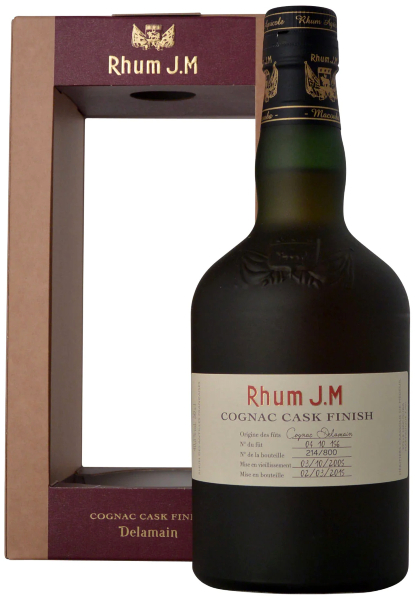This is the fourth review of a Rhum J.M from Martinique on these pages. After the other three I tasted and reviewed here: Cuvée 1845, Millésime 2002 and XO, I more than happily bought a set of three special cask finishes, the Cognac finish at hand but there was also a Calvados finish as well as an Armagnac finish. For popping the cork on one of these three, I chose this Cognac finish first, because around the time of opening I also had this Port Charlotte CC:01 open (CC = Cognac Cask), and I wanted to see if the Cognac bit would be a common thread between the two. I never actually really got to comparing the two back then, it would have made no sense anyway, comparing a Rhum Agricole to a Peated Whisky (higher in ABV as well). The CC:01 is now long gone, and remembering the taste of it and comparing it, from memory, to this J.M, nope, not really clear in any of them that it had to do with Cognac. Not really sure what markers to look for to be honest, because both do not taste like a Cognac whatsoever. The label states that the Rhum aged for 8 years in Ex-Bourbon casks and was finished for several months in 350 litre Cognac casks. Less than 5 full months in this case, since this was distilled on 03/10/2005 and bottled 02/03/2015.
 Color: Full gold, just shy of orange gold.
Color: Full gold, just shy of orange gold.
Nose: I haven’t tried the Calvados finish yet, but if I had gotten this blind, I would say this would be the Calvados version, because it smells of apples and…well, Calvados. There is something Calvados-y about a Rhum Agricole anyway. So this one is fruity, slightly sugary as well and overall very pleasant. Definitely a sunny expression. Well balanced yet on the nose not very complex. Nice soft wood, with nice soft ripe yellow exotic fruits and thus apples. No citrus and not acidic, not sweet either. Lots of fruit and it keeps on coming, overpowering the wood entirely now, yet leaving room for a more creamy and vanilla-like aroma, giving it some more body. Also, a more earthen and dusty note pops up, as well as some sunshine after rain and now, after sipping, some licorice, runny caramel and chewy toffee comes forth. A wonderful, friendly and positive nose, bringing the Caribbean to my home on this grey March day. I needed to work this nose a bit, but now that it is there, I very much like the J.M character in this again. It is a special spirit. Smells great. After a while in my glass some (sweet) licorice notes pop up, giving it slightly more backbone.
Taste: Aiii, 40.5% ABV was a mistake. Quite dull on entry. However, it starts most definitely again with the apply and/or the Calvados-y note I also got from the nose. Medium sweet and definitely fruity. The wood exerts itself some more here and also shows some bitterness, adding some spices to the whole. It is waxy and slightly nutty. By the way, the bitterness depends a bit on the day and, as always, depends very much too on you as a taster, because the second time around I found it less bitter then the first time. Simpler than the nose was, and simple is the right word here. It is less balanced as well. I’m missing a part of the big fruit that came from the nose, where is that? So less fruit is noticeable, probably because there is more soft wet wood and spicy wood on the palate that sticks to the roof of my mouth. The palate is definitely closer to a Cognac than a Calvados, and differs quite a lot from the nose. Now I would give it more than 9yo. The body is alright, a bit of a mediocre, yet nice, Rhum Agricole to be honest. However, I liked all three J.M’s I reviewed earlier more. This one seems to be not quite sure about its identity. It’s a bit thin and after the sunny nose a bit too bitter as well. Nope, not a fan of this particular one. A great R(h)um is never great by the nose alone.
When sipping this casually, I never cared too much for it, but I always thought that was because of my carelessness when sipping, so when analysing it I was really surprised how great the nose really is. I must have been wrong all this time. However now that I have tasted it again, I know exactly why I didn’t care for it all that much. It falls really short on the palate, at least it doesn’t gel with me. Seems to be lacking some balance, and the less interesting note on the palate seem to dominate over the more pleasant ones. It reminds me a bit of a Whisky that has seen a wee bit to much air in its lifetime. Maybe this J.M doesn’t like air all too much. Ah well, you can’t win them all.
Points: 80
 Color: Orange gold. No red hue.
Color: Orange gold. No red hue. Color: Orange gold.
Color: Orange gold. Color: Light orange gold. Batch 006 is ever so slightly darker.
Color: Light orange gold. Batch 006 is ever so slightly darker. Color: White Wine
Color: White Wine Color: Light gold.
Color: Light gold. Color: Gold.
Color: Gold. Color: Gold.
Color: Gold. Color: White Wine.
Color: White Wine. Color: Very light, lightly coloured water, not even White Wine.
Color: Very light, lightly coloured water, not even White Wine.